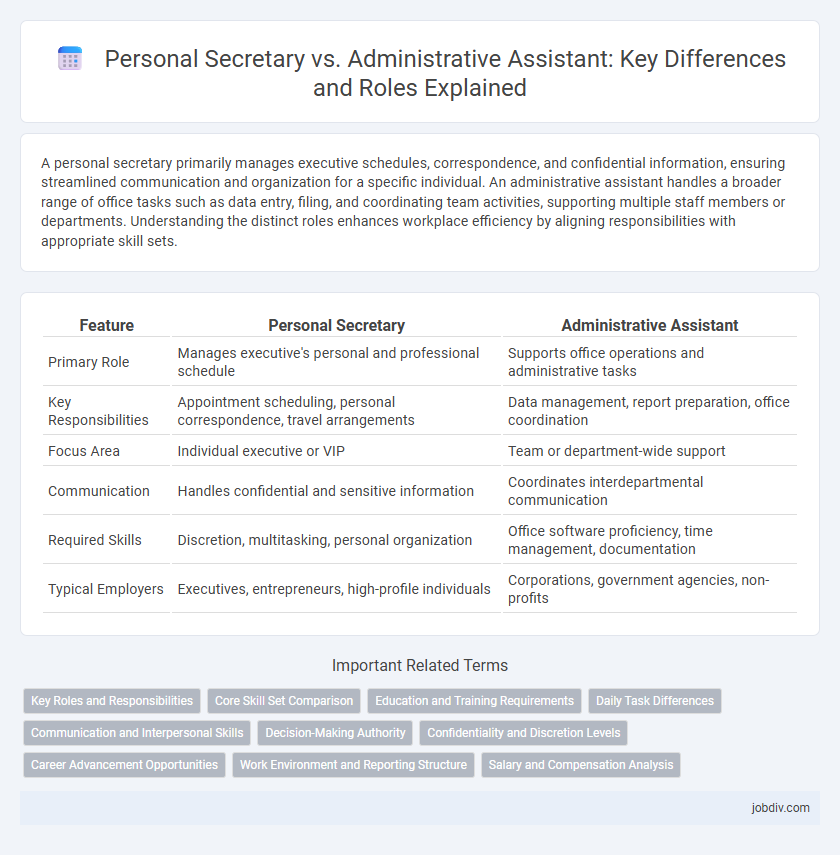A personal secretary primarily manages executive schedules, correspondence, and confidential information, ensuring streamlined communication and organization for a specific individual. An administrative assistant handles a broader range of office tasks such as data entry, filing, and coordinating team activities, supporting multiple staff members or departments. Understanding the distinct roles enhances workplace efficiency by aligning responsibilities with appropriate skill sets.
Table of Comparison
| Feature | Personal Secretary | Administrative Assistant |
|---|---|---|
| Primary Role | Manages executive's personal and professional schedule | Supports office operations and administrative tasks |
| Key Responsibilities | Appointment scheduling, personal correspondence, travel arrangements | Data management, report preparation, office coordination |
| Focus Area | Individual executive or VIP | Team or department-wide support |
| Communication | Handles confidential and sensitive information | Coordinates interdepartmental communication |
| Required Skills | Discretion, multitasking, personal organization | Office software proficiency, time management, documentation |
| Typical Employers | Executives, entrepreneurs, high-profile individuals | Corporations, government agencies, non-profits |
Key Roles and Responsibilities
A Personal Secretary manages confidential communications, schedules, and personal tasks for executives, ensuring seamless daily operations and prioritizing personalized support. An Administrative Assistant handles broader office duties such as organizing meetings, maintaining records, and coordinating team activities, focusing on overall administrative efficiency. Key responsibilities of a Personal Secretary center on discreet executive assistance, while an Administrative Assistant supports organizational workflow and staff coordination.
Core Skill Set Comparison
A Personal Secretary excels in managing schedules, handling confidential communications, and organizing personal appointments with exceptional discretion and attention to detail. An Administrative Assistant specializes in coordinating office operations, supporting multiple executives, and managing documentation and communication flow across departments. Core skills for Personal Secretaries emphasize privacy and personalized support, while Administrative Assistants focus on multitasking, office administration, and team collaboration.
Education and Training Requirements
Personal Secretaries typically require a high school diploma with on-the-job training or a certificate in office administration, while Administrative Assistants often hold an associate degree or higher in business administration. Specialized courses in communication, computer software, and organizational skills enhance qualifications for both roles but are more comprehensive for Administrative Assistants. Industry certifications such as Certified Administrative Professional (CAP) can significantly boost career prospects and professional credibility in administrative positions.
Daily Task Differences
Personal secretaries primarily manage an executive's schedule, handle confidential correspondence, and coordinate personal and professional appointments. Administrative assistants focus on broader office support tasks such as organizing files, managing communications for multiple team members, and preparing reports or presentations. While both roles require strong organizational skills, personal secretaries often deal with more personalized, high-level tasks tailored to one individual.
Communication and Interpersonal Skills
Personal Secretaries excel in communication by managing confidential information and acting as the primary liaison between executives and external contacts, requiring exceptional discretion and relationship-building skills. Administrative Assistants demonstrate strong interpersonal abilities through multitasking in diverse office environments, coordinating team communications, and facilitating workflow among various departments. Both roles demand clear, professional communication and adaptability, but Personal Secretaries often engage in more personalized and confidential interactions.
Decision-Making Authority
A Personal Secretary typically holds greater decision-making authority, managing confidential schedules, correspondence, and often making executive decisions on behalf of their employer. Administrative Assistants generally execute more routine tasks, supporting broader office functions without the same level of autonomy in decision-making. The distinction in authority impacts the scope of responsibilities and influence within organizational hierarchy.
Confidentiality and Discretion Levels
A Personal Secretary typically handles highly sensitive information and private matters for executives, requiring elevated confidentiality and discretion levels to protect personal and professional boundaries. In contrast, an Administrative Assistant manages broader organizational tasks, where confidentiality remains important but is generally applied to less sensitive data. The distinction in discretion levels reflects the Personal Secretary's closer, more trusted relationship with specific individuals.
Career Advancement Opportunities
Personal Secretaries often excel in managing executive schedules and confidential communications, providing a direct pathway to high-level support roles and potentially executive assistant positions. Administrative Assistants gain diverse office management experience that can lead to broader career paths in office administration, project coordination, or human resources. Both roles offer unique advancement opportunities, but Personal Secretaries typically experience faster career growth within corporate hierarchies due to their close interaction with top executives.
Work Environment and Reporting Structure
Personal Secretaries typically work in close proximity to high-level executives, often within private offices, ensuring direct and immediate access to their employer for efficient task management. Administrative Assistants generally operate in shared office spaces, supporting multiple team members or departments, which requires balancing various priorities and communication channels. The reporting structure for Personal Secretaries is usually singular and hierarchical, directly accountable to one executive, while Administrative Assistants often report to department managers or office administrators, reflecting broader organizational integration.
Salary and Compensation Analysis
Personal Secretaries typically earn slightly higher salaries than Administrative Assistants, with average annual wages ranging from $45,000 to $60,000 depending on industry and experience. Compensation packages for Personal Secretaries often include performance bonuses and benefits tailored to executive support roles, reflecting their specialized responsibilities. In contrast, Administrative Assistants generally receive salaries between $35,000 and $50,000, with compensation focused on standard benefits and occasional overtime pay.
Personal Secretary vs Administrative Assistant Infographic

 jobdiv.com
jobdiv.com